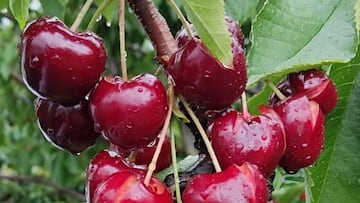Three fruit trees that you must prune in March if you want to get the big harvest of the year in the summer
With Spring around the corner, plants, trees and shrubs will soon be bursting into bloom. Now’s the time to get your pruning shears out.

As the final days of winter make way for spring, we will soon be witnessing trees, shrubs and plants burst into bloom and start bearing their fruits. A vibrant transformation that fills streets, gardens and fields with a dazzling array of colors. However, it also brings the inevitable waves of pollen - not good for those who are sensitive to seasonal allergies.
While nature tends to flourish on its own, we can lend a helping hand to a bountiful harvest is reaped a few months down the line in summer. One of the most common and effective methods is to prune fruit trees, and the best time to do so is right now in March. Proper pruning can have a substantial impact on both the quality and quantity of the fruit these trees produce.
Lemon tree mass pruning machine
— Massimo (@Rainmaker1973) February 24, 2025
[📹 rooted_asset_management_1]pic.twitter.com/DaZ7X5IsJY
Why prune trees at all and why now?
Early spring is when trees begin to awaken from their winter dormancy. Their buds have yet to break, making it an ideal moment to shape their growth and set the stage for a fruitful season ahead. By removing dead or excess branches, you’re not only giving them a fresh start but also redirecting their energy. Pruning allows the tree to grow low branches, balances growth and the root system to keep it from getting top-heavy.
Trees enter a dormant phase during winter, which makes them less susceptible to the impacts of pruning cuts. When temperatures begin to rise in early spring, the process of wound healing is encouraged, enabling trees to recover more effectively. During dormancy (February to early April), sap flow is not at its peak, which minimizes the risk of excessive bleeding. If sap loss is too great, it can weaken the tree and decrease its productivity.
By pruning at this stage, trees are prepared for optimal blooming. Damaged branches from the winter are removed, allowing the tree to redirect its energy towards producing new shoots. In turn, this increases the flow of light and air into the tree’s center, reducing the risk of disease and promoting fruit ripening. This method applies to trees that are over three years old. Newly-planted fruit trees should be pruned in the summer, after new growth has begun to sprout from the initial cuts.
An apple tree that is properly pruned can improve its yield by up to 20%, as well as enhancing its overall health and longevity.
There are two basic pruning methods: thinning cuts and heading cuts. Thinning cuts are used to remove entire branches. It helps to improve air circulation and sunlight penetration without stimulating excessive new growth. Heading cuts involve cutting the tip of a branch to encourage branching and promote a fuller tree structure.
Apple tree pruning
When pruning apple trees, vertical branches should be cut rather than the ones that spread out horizontally, as they tend to bear more fruit. Cuts should be made just beyond outward-facing buds to encourage open growth, ensuring better light exposure for evenly ripening apples. This approach is particularly advantageous in regions with cloudy summers, where maximizing sunlight is key to uniform fruit maturation.
Cherry tree pruning
Cherry trees requires special care. While it’s generally best to prune lightly after the flowering period, it’s also beneficial to do a minor trim in March. This helps remove dead wood and thin out the foliage, ensuring better airflow and sunlight penetration.
And remember, cherry trees are very sensitive. Heavy cuts can lead to significant bleeding, which can be harmful to the tree’s health. For this reason, experts recommend thinning cuts to create space for new growth, while preserving the tree’s vitality. By handling it with care, you can encourage a healthier, more productive cherry tree.
Pear tree pruning
Pruning pear trees also requires a more delicate approach compared to apple trees to avoid over-stressing them. It’s important to remove only dead and crossing branches, allowing for better air circulation. Experts recommend shaping the tree into a pyramidal structure, maintaining one central branch as the main support.
This form is crucial for helping the tree bear the weight of its fruit during the summer, as pears tend to grow close to the trunk. By carefully pruning, you not only strengthen the tree’s framework but also set the stage for healthy and abundant fruit production in the summer months.
By understanding these techniques and the best time to get your pruning shears out, you can ensure that your fruit trees remain healthy, vibrant and productive for years to come.
Related stories
Get your game on! Whether you’re into NFL touchdowns, NBA buzzer-beaters, world-class soccer goals, or MLB home runs, our app has it all.
Dive into live coverage, expert insights, breaking news, exclusive videos, and more – plus, stay updated on the latest in current affairs and entertainment. Download now for all-access coverage, right at your fingertips – anytime, anywhere.
Complete your personal details to comment